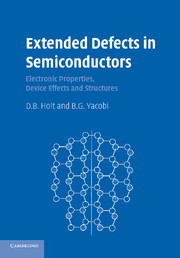Book contents
- Frontmatter
- Contents
- Preface
- 1 Semiconducting materials
- 2 An introduction to extended defects
- 3 Characterization of extended defects in semiconductors
- 4 Core structures and mechanical effects of extended defects specific to semiconductors
- 5 The electrical, optical and device effects of dislocations and grain boundaries
- 6 Point defect materials problems
- Index
- References
5 - The electrical, optical and device effects of dislocations and grain boundaries
Published online by Cambridge University Press: 10 September 2009
- Frontmatter
- Contents
- Preface
- 1 Semiconducting materials
- 2 An introduction to extended defects
- 3 Characterization of extended defects in semiconductors
- 4 Core structures and mechanical effects of extended defects specific to semiconductors
- 5 The electrical, optical and device effects of dislocations and grain boundaries
- 6 Point defect materials problems
- Index
- References
Summary
Introduction to the electrical effects of dislocations and other defects in semiconductors
In this chapter the historically important influence of high densities of dislocations on the electrical properties of semiconductors and on device performance is first outlined. (In the early days of semiconductor studies, high densities were generally either grown-in or introduced into the material by plastic deformation.) The mechanisms giving rise to the electronic and luminescence properties of dislocations and other defects are next treated. The role of defects in devices is discussed. The electrical properties of grain boundaries in polycrystalline semiconductors are also treated.
Introduction
The first short paper reporting that plastic deformation of Ge and Si was possible at raised temperatures, also reported that this increased the resistivity of Ge and the lifetime of photo-injected carriers was greatly reduced (Gallagher 1952). Further early studies revealed that <1% plastic strain would eliminate all the electrons in lightly doped n-type Ge and turn it p-type. (Ge was the important semiconductor at that time.) The effects of dislocations were so important that much basic dislocation theory is due to workers in the pioneering group at Bell Laboratories, especially Shockley (who introduced ‘dangling bonds’ and Shockley partial dislocations) and Read (of the Frank-Read source and the first theory of the electrical effects of dislocations). However, the industrial laboratories lost interest once it was found possible to grow low or zero dislocation density Si and effectively avoid or passivate process-induced dislocations.
- Type
- Chapter
- Information
- Extended Defects in SemiconductorsElectronic Properties, Device Effects and Structures, pp. 412 - 605Publisher: Cambridge University PressPrint publication year: 2007



